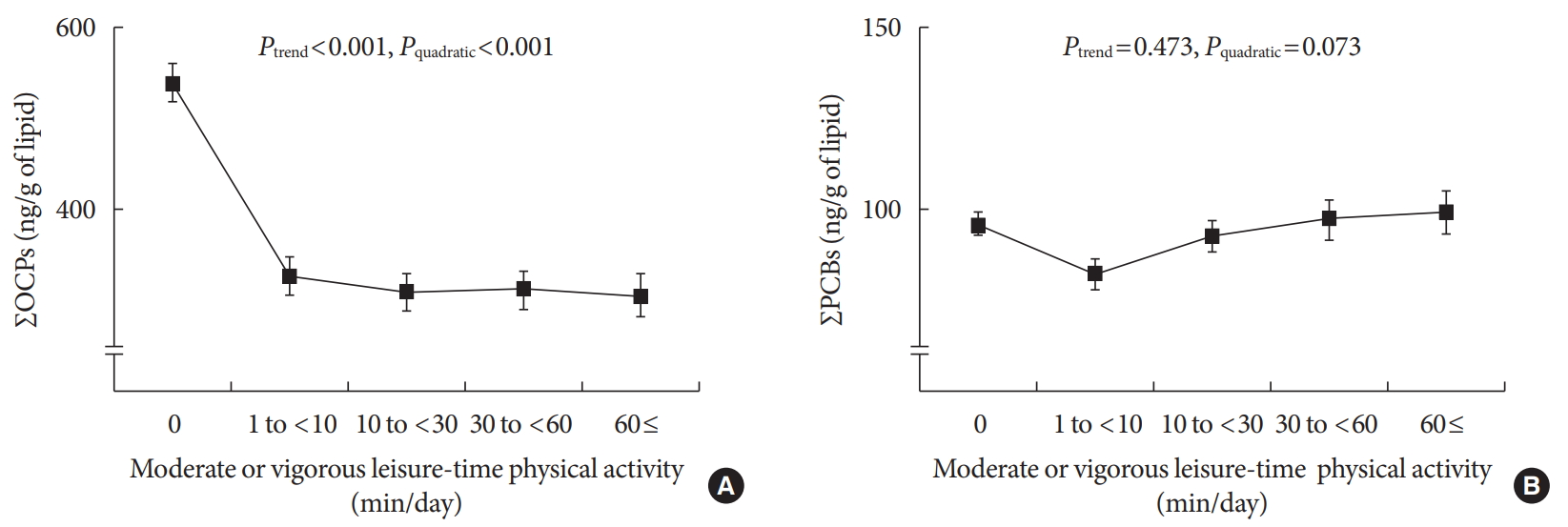
- Current
- Browse
- Collections
-
For contributors
- For Authors
- Instructions to authors
- Article processing charge
- e-submission
- For Reviewers
- Instructions for reviewers
- How to become a reviewer
- Best reviewers
- For Readers
- Readership
- Subscription
- Permission guidelines
- About
- Editorial policy
Search
- Page Path
- HOME > Search
- Others
- Can Habitual Exercise Help Reduce Serum Concentrations of Lipophilic Chemical Mixtures? Association between Physical Activity and Persistent Organic Pollutants
- Yu-Mi Lee, Ji-Yeon Shin, Se-A Kim, David R. Jacobs, Duk-Hee Lee
- Diabetes Metab J. 2020;44(5):764-774. Published online May 11, 2020
- DOI: https://doi.org/10.4093/dmj.2019.0158

- 5,408 View
- 87 Download
- 5 Web of Science
- 7 Crossref
-
 Abstract
Abstract
 PDF
PDF Supplementary Material
Supplementary Material PubReader
PubReader  ePub
ePub Background Low-dose persistent organic pollutants (POPs), especially organochlorine pesticides (OCPs), have emerged as a new risk factor of many chronic diseases. As serum concentrations of POPs in humans are mainly determined by both their release from adipose tissue to circulation and their elimination from circulation, management of these internal pathways may be important in controlling the serum concentrations of POPs. As habitual physical activity can increase the elimination of POPs from circulation, we evaluated whether chronic physical activity is related to low serum POP concentrations.
Methods A cross-sectional study of 1,850 healthy adults (age ≥20 years) without cardio-metabolic diseases who participated in the U.S. National Health and Nutrition Examination Survey 1999 to 2004 was conducted. Information on moderate or vigorous leisure-time physical activity was obtained based on questionnaires. Serum concentrations of OCPs and polychlorinated biphenyls were investigated as typical POPs.
Results Serum concentrations of OCPs among physically active subjects were significantly lower than those among physically inactive subjects (312.8 ng/g lipid vs. 538.0 ng/g lipid,
P <0.001). This difference was maintained after adjustment for potential confounders. When analyses were restricted to physically active subjects, there were small decreases in the serum concentrations of OCPs with increasing duration of physical activity, showing a curvilinear relationship over the whole range of physical activity (P quadratic <0.001). In analyses stratified by age, sex, body mass index, and smoking status, a strong inverse association was similarly observed among all subgroups.Conclusion Physical activity may assist in decreasing serum concentrations of lipophilic chemical mixtures such as OCPs.
-
Citations
Citations to this article as recorded by- Is Physical Activity an Efficient Strategy to Control the Adverse Effects of Persistent Organic Pollutants in the Context of Obesity? A Narrative Review
Quentin A. Serrano, Sébastien Le Garf, Vincent Martin, Serge S. Colson, Nicolas Chevalier
International Journal of Molecular Sciences.2024; 25(2): 883. CrossRef - Physical exercise and persistent organic pollutants
Chang Liu, Hui sheng Hou
Heliyon.2023; 9(9): e19661. CrossRef - Exposure to a low concentration of mixed organochlorine pesticides impairs glucose metabolism and mitochondrial function in L6 myotubes and zebrafish
Chul-Min Park, Ki-Tae Kim, Dong-Young Rhyu
Journal of Hazardous Materials.2021; 414: 125437. CrossRef - Can Environmental Pollutants Be a Factor Linking Obesity and COVID-19?
Duk-Hee Lee
Journal of Korean Medical Science.2021;[Epub] CrossRef - Letter to the Editor: Effect of fatty fish or nut consumption on concentrations of persistent organic pollutants in overweight or obese men and women: A randomized controlled clinical trial
Yu-Mi Lee, Duk-Hee Lee
Nutrition, Metabolism and Cardiovascular Diseases.2020; 30(5): 849. CrossRef - Can habitual exercise really increase serum concentrations of persistent organic pollutants?
Yu-Mi Lee, Duk-Hee Lee
Environment International.2020; 140: 105615. CrossRef - Response to correspondence ENVINT_2020_552 “Can habitual exercise really increase serum concentrations of persistent organic pollutants?”
Sidsel L. Domazet, Tina K. Jensen, Anders Grøntved
Environment International.2020; 140: 105616. CrossRef
- Is Physical Activity an Efficient Strategy to Control the Adverse Effects of Persistent Organic Pollutants in the Context of Obesity? A Narrative Review

 KDA
KDA
 First
First Prev
Prev





